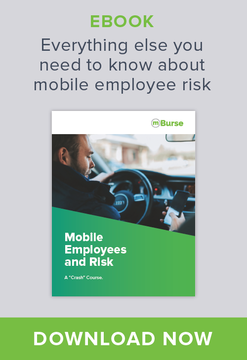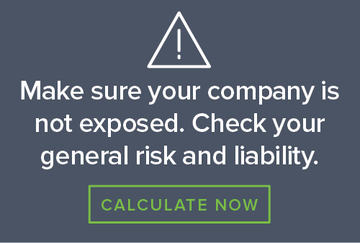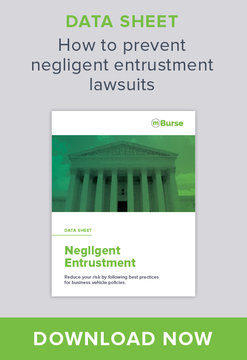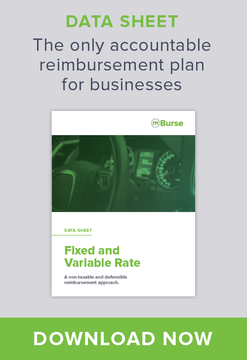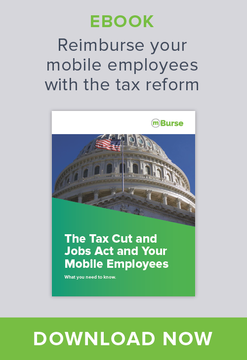Employees driving personal vehicles for work: What's your risk?
Our ultimate guide to negligent entrustment, respondeat superior, employee car insurance, vehicle reimbursement laws, and taxation.
 It is a 6 minute read
It is a 6 minute read
What's your mobile workforce risk?
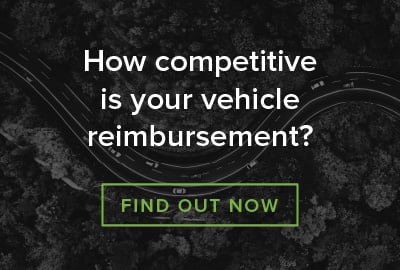

INTRODUCTION:
CHAPTER :
Risks from employees driving personal vehicles
Risks from employees driving personal vehicles
Your organization faces serious risks every time an employee gets behind the wheel of a vehicle while on the job. The larger your mobile workforce, the higher the risk.
A mobile employee needs a vehicle to fulfill his or her job responsibilities, often working in sales, light service, account management, or merchandising. Mobile employees often drive thousands of miles annually and constitute the face of the organization.
Mobile workforce risk includes any potential threats to a company’s wellbeing arising from employee vehicle travel, especially factors that can result in financial loss. This guide will help your organization develop a set of risk management practices specifically tailored to employee vehicle travel.
What risks come with employees driving personal vehicles?
For starters, car accidents. Every time a mobile employee hits the road, you’re exposed to vicarious liability for damages, to negligent entrustment lawsuits (i.e. respondeat superior), to bad publicity.
And then you’ve got labor codes and IRS regulations to consider. How do you know the company is fully complying with the complex system of laws governing the reimbursement of mobile employees? California, Illinois, and Massachusetts reimbursement laws are particularly challenging and will get their own chapter below.
Read on to learn best practices to manage each category of employee vehicle risk.
CHAPTER :
The risk of employee car accidents and respondeat superior
The risk of employee car accidents and respondeat superior
Every year, the National Highway Traffic Safety Administration (NHTSA) produces data on vehicle crashes in the United States. In 2021, the most recent year for which statistics are available, police reported over 6.1 million accidents.
That’s nearly 17,000 per day – about 12 accidents every minute. Let that sink in.
When you consider traffic volume, you know that most accidents occur during the workday – when your mobile employees are carrying out their jobs. It’s not a question of if but when an employee causes an accident.
The biggest risks you face involve the twin legal doctrines of vicarious liability and respondeat superior – when an employer is held responsible for the actions of an employee.
Employee vehicle accidents and employer insurance liability
When a motorist gets hit by another motorist, they and their auto insurance company want to make sure the other motorist’s insurance picks up the tab. And if injuries occur, they are probably ringing up a ton of medical bills.
But what if the at-fault driver’s auto insurance can’t cover all these costs? That’s when the victims, knowing that the driver was on the job and relying on the tort law doctrine of respondeat superior will come after the driver’s employer.
Mandating employee auto insurance liability limits
Because of respondeat superior, every organization should have a policy that sets minimum auto insurance liability limits for all mobile employees – and sets them high. Every organization should also regularly verify that each employee meets the minimum auto insurance requirements.

Employee vehicle accidents and negligent entrustment
Employee auto insurance is not the only form of vicarious liability for employee-caused car accidents. There’s another threat: negligent entrustment.
Negligent entrustment is a tort law concept that refers to the insufficient vetting of an employee by an employer.
Criteria to establish negligent entrustment of a vehicle
If the victim of the crash can prove that the at-fault driver’s employer was negligent in entrusting that employee with responsibilities that required operating a vehicle, then the victims can sue the company.
All they have to do is convince a judge that the employee was incompetent, reckless, or
Adopting a safety policy with motor vehicle record checks
This is why your organization should have an employee vehicle safety policy. This policy should require routine motor vehicle record (MVR) checks, promote safe driving, and detail a process for addressing incidents that increase a driver’s risk profile.
To reduce vicarious liability for employee-involved auto accidents, it’s important to follow best practices. Let’s look at a few.
CHAPTER :
How to reduce liability for employee car accidents
How to reduce liability for employee car accidents
No matter what you do, if you have employees on the road, vehicle accidents will occur within the company. Risk management means protecting the company and the employee from unnecessary financial exposure. Here’s how to do it:
1. Mandate each employee’s minimum auto insurance liability limits.
Every car insurance policy includes three liability limits that your company should dictate for each employee:
Bodily injury per person: The maximum amount the insurer will pay for a single person’s injuries, per incident.
Bodily injury per accident: The maximum total amount the insurer will pay for all injured persons, per incident.
Property damage: The maximum amount the insurer will pay for all damages to another person’s property, per incident.
State minimum auto insurance liability limits
Nearly every state requires these insurance coverages, but no state sets them high enough to cover a serious accident involving multiple injuries. California law, for example, requires a minimum coverage of $15,000 for bodily injury per person, $30,000 for bodily injury per accident, and $5,000 for property damage – expressed as a 15/30/5 policy
The Insurance Information Institute, however, reports that the average bodily injury claim in 2022 was $24,211. Many of these claims would exceed California's minimum coverage. In fact, very few states require anything beyond a 25/50/15 policy – fine for a fender-bender but not for a serious accident involving injuries.
If you don’t have a policy requiring a minimum employee auto insurance coverage, or your policy merely mandates the state minimum, then your organization faces serious risk exposure.
2. Set the auto insurance liability limits high.
If you want to protect both the company and employees, you need to go with a 250/500/100 policy for all employees. The popular 100/300/50 policy could still leave you exposed. A vehicle accident that causes over $300,000 in medical claims is rare, but it does happen.
With dozens or even hundreds of employees on the road every week, year after year, do the math – a rarity becomes an increasing possibility.
Reimbursing employee auto insurance premiums
Make sure your employees can afford the higher auto insurance coverage. It’s not right to mandate a higher amount to protect the organization but not bump up the car allowance or reimbursement amount. It also violates the reimbursement laws in some states, including California, Illinois, and Massachusetts, if you require coverage that exceeds the state minimum but fail to reimburse employees fully for it.
3. Verify employee car insurance every six months.
An unenforced policy is no policy. Employees may drop coverage or decrease coverage in order to save money. You need to make sure this doesn’t happen.
Since most car insurance policies renew every six months, it makes sense to conduct bi-annual employee insurance verifications. No matter how good your policy is, employee compliance ultimately determines your risk.
CHAPTER :
How to prevent negligent entrustment lawsuits
How to prevent negligent entrustment lawsuits
The key to reducing the risk of negligent entrustment is a written employee vehicle safety policy. Getting your ducks in a row, taking swift action when necessary, and keeping excellent written records is your best protection in the event of an employee-caused auto accident.
Follow these tips to develop a robust vehicle safety policy:
1. Conduct routine employee motor vehicle record checks.
In the case of negligent entrustment, what you don’t know will hurt you. You cannot plead ignorance if an employee causes a car accident, and it turns out that
Annual MVR checks
Most organizations check employee motor vehicle records (MVRs) as part of the hiring process. This is a great practice, but it has to continue on a regular basis. Driving records change over time. In a short period of time, an employee may rack up a couple of speeding tickets, or even worse, pick up a DUI.
You have to know as soon as possible so that you can take appropriate actions. At a minimum, annual MVR checks are necessary.
Continuous monitoring of MVRs
Because negligent entrustment lawsuits can cost millions of dollars, some organizations opt for continuous monitoring in lieu of annual MVR checks. This alternative is expensive, but the employer knows immediately when an employee has been charged with a moving violation.
2. Maintain a vehicle risk profile for every employee driver.
Not all incidents that appear on an MVR check are equally severe. Establish a rating system that categorizes employees as low-risk, medium-risk, or high-risk. Update each employee’s score as new information comes in.
Points equalization system
Most states maintain a points system to indicate driver safety. The number of points on a driver’s record (hopefully none!) can be a helpful indicator. But be aware that different states use different points systems. For example, driving without a license generates 10 points in Texas but only 2 points in California.
As a result, you need a points equalization system that translates different state’s points into the company’s internal risk-scoring system.
3. Set clear safety policies for employee driving and clear consequences for violations.
An employee with a low-risk vehicle score needs no correction – just keep checking MVRs for changes. But to protect the company from vicarious liability, you need to intervene when an employee has a violation.
Driver safety interventions
Appropriate interventions could include:
- a written warning
- an online driver safety course
- continuous monitoring
- behind-the-wheel training
- termination
The higher the employee’s risk of an accident, the higher the company’s risk of negligent entrustment. Every company needs to decide what’s an acceptable level of risk, but in our litigious society, it doesn’t take much to establish vicarious liability against the employer.

4. Keep excellent records of employee vehicle policies and interventions.
Maintain a clear written record of all safety policies. Regularly refresh employee understanding. Put all interventions in writing, and update an employee’s vehicle risk profile every time a corrective action occurs. If a negligent entrustment suit occurs, these records can prove that you took steps to reduce an employee’s safety risk.
5. Be proactive about increasing employee driver safety.
You cannot prevent all accidents, but you may be able to prevent some. The key is to establish clear expectations for safe driving, to reinforce these expectations, and to give consequences for violations.
Distracted driving
First and foremost, you must address distracted driving. In 2021, 3,522 people died in accidents caused by distracted driving. And 98% of respondents to a 2014 survey agreed that texting while driving is dangerous, yet 74% did it anyway. If three-quarters of the populace texts while driving – even though it’s illegal in 48 states, and everyone knows it’s dangerous – you can bet your employees do it.
Company culture and driver safety
It is vital that the company not only establish policies that prohibit cell phone use while driving but also that the company creates a culture of compliance. If mobile employees feel pressure to conduct business while driving, they may follow company “practice” rather than company policy.
For more ideas of how to incentivize good driving, read OSHA's "Guidelines for Employers to Reduce Motor Vehicle Crashes."
CHAPTER :
Indemnification codes and California reimbursement law
How to comply with indemnification codes and California reimbursement law
Car accidents may be the most obvious source of risk, but state labor codes pose a more subtle set of risks. Several states have added specific protections to the take-home pay of employees. Under these employee indemnification codes, employers that don’t fully protect their employees’ pay in accordance with the law can be subject to fines and lawsuits.
What states offer legal protections to employees from employer business expenses?
These “pro-employee” states include California, Illinois, Massachusetts, Rhode Island, North Dakota, South Dakota, Michigan, Montana, New Hampshire, and New York.
No state has a stricter employee expense indemnification code than California. If you can comply with California’s employee reimbursement laws, you’ll be protected anywhere.
CA Labor Code Section 2802(a) states that:
“An employer shall indemnify his or her employee for all necessary expenditures or losses incurred by the employee in direct consequence of the discharge of his or her duties, or of his or her obedience to the directions of the employer.”
Furthermore, Section 2802(c) defines “necessary expenditures or losses” to include “all reasonable costs.”
California's indemnification labor law clearly requires employers to reimburse employees for all reasonable expenses related to the business use of a personal vehicle. (Business use does not include the commute between home and work.)
These expenses include more than just gas. Tires, maintenance, depreciation, auto insurance, taxes, and registration all can be considered reasonable costs.
What reimbursement methods comply with California's labor laws?
The California Supreme Court laid it out in the 2007 decision Gattuso v. Harte-Hanks Shoppers, Inc. According to the Court, the following methods can comply with the law:
1. The IRS mileage rate – paying a cents-per-mile rate set by the federal government each year to guide individual tax deductions for business miles driven.
2. The actual expense method – reimbursing the actual expenses, demonstrated through employee receipts.
3. The lump-sum method – pays a car allowance based on the employee’s personal vehicle expenses; this car allowance must provide full reimbursement.
Reimbursement method pros and cons
None of these methods provides a perfect solution, however. Each carries distinct advantages and disadvantages:
| Type | Pros | Cons |
|---|---|---|
| Mileage Reimbursement | Simple to administer | May over-reimburse high-mileage drivers and under-reimburse low-mileage drivers |
| Actual Expense | The most precise method. | Administratively difficult; requires tedious record-keeping and tracking receipts |
| Lump Sum or Allowance | Simple to administer | Taxes reduce the take-home amount, making this method the most inefficient |
Most companies opt for the IRS mileage rate or a monthly car allowance because these are the easiest to administer. However, both create a problem of inequity.
Equal reimbursement rate vs. unequal expenses
Think about it: different employees experience different costs, yet the employer reimburses them the same amount. Territory size, employee role, and geographically-sensitive costs all differ across a single company.
Not only is a standard reimbursement unfair to the employees with the highest costs,
Similarly, if you pay a mileage rate, high-mileage drivers can drive costs beyond what’s necessary for sufficient reimbursement. The same organization could also employ low-mileage drivers whose mileage is too low to cover all their business vehicle costs.
Inequitable compensation can dampen productivity and increase attrition rates, further increasing company costs and adding overall risk.
So what’s the best way to comply with indemnification labor codes?
The answer is...none of the above! The best method is fixed and variable rate reimbursement, also known as FAVR. The next chapter will explain why this approach works better than all others.
CHAPTER :
Fixed and Variable Rate Reimbursement (FAVR)
Fixed and Variable Rate Reimbursement (FAVR)
The best way to reimburse California employees for a personal vehicle: FAVR reimbursement.
Also known as a FAVR car allowance, fixed and variable rate reimbursement divides mobile employee expenses into fixed and variable categories:
| Fixed expenses | Variable expenses |
|---|---|
| Auto insurance | Fuel |
| Depreciation | Maintenance |
| Taxes and registration | Tires |
The employer then pays a fixed monthly amount plus a variable mileage rate, all based on cost data for each employee’s territory and garage zip code. This means different employees receive different reimbursement amounts that accurately reflect their reimbursement needs.
Advantages of FAVR vehicle reimbursement:
- Non-taxable
- Controls costs
- Defensible
- Accurate
- Equitable
The actual expense method carries each of these advantages as well. But there’s a reason most companies avoid it: the administrative expense of time and energy spent tracking and reporting receipts.
A FAVR car allowance involves greater administrative complexity than mileage reimbursement or a traditional car allowance, but a number of third-party organizations have created cost-effective ways to administer a FAVR vehicle program, making it the best option for a company seeking to comply with CA Labor Code 2802.
Reimbursing California employees for personal vehicle use in 2024
You have to treat reimbursement of California employees differently from reimbursement of other employees. It's an expensive state in which to own and operate a vehicle. In 2019, the gas tax began the process of increasing incrementally, based on inflation. Many motorists in California are paying $5 per gallon or more. If you have California drivers but are not using FAVR to reimburse them, there's a good chance you are either violating the employee indemnification law, or you are facing out of control company costs.
Resources for California vehicle reimbursement compliance
If you would like to learn more about car allowances, mileage reimbursements, or FAVR vehicle programs, we have created a helpful guide to each form of employee vehicle reimbursement.
Everything You Need to Know about Car Allowances - Your definitive guide to developing an effective car allowance policy.
Everything You Need to Know about Mileage Reimbursements - Your definitive guide to mileage reimbursements for personal vehicles.
The Ultimate Guide to Understanding FAVR - How customizable, tax-free reimbursement helps companies stay on mission no matter the economic situation.
CHAPTER :
Tax liability from employee vehicle reimbursements
Tax liability from employee vehicle reimbursements
Adopting a FAVR vehicle plan can also help protect your company from some of the risks associated with our country’s complex tax code.
What taxation liabilities come with car allowances and reimbursements?
The tax-related risks and liabilities come from a failure in one or more of the following categories:
1. Proper withholding of taxes from car allowances.
2. Chargebacks for personal use of a company car.
3. Chargebacks for personal use of a fuel card.
To understand the potential tax liabilities associated with these practices, it helps to distinguish between two IRS categories for employee vehicle reimbursement:
IRS Accountable Vehicle Plan
An accountable plan requires employees to substantiate the business connection of an expense within a reasonable amount of time. Employees must pay back any excess advances in a reasonable amount of time. An accountable plan is non-taxable.
IRS Non-Accountable Vehicle Plan
A non-accountable plan does not require employees to substantiate the business connection of an expense. Any non-accountable amounts are considered income to the employee and must be included as wages with appropriate tax withholdings.
 |
 |
Tax liability for a typical $600 monthly car allowance
If your organization uses a non-accountable method such as a car allowance, you need to make sure that you are properly withholding taxes each month from employees.
An employee in the 32% tax bracket receiving a $600/month allowance could have as much as $238 withheld for federal income taxes and FICA. And don’t forget that the company needs to pay its share of FICA (7.65%) on that amount.
The tax waste generated by a non-accountable vehicle reimbursement plan can be massive, making the extra time spent administering an IRS accountable plan worth it.
Tax risks for accountable vehicle reimbursements
Even an accountable plan can generate taxable income. If an employee doesn’t pay back excess advances, then the employer needs to tax the excess as income.
This situation can arise if you offer a car allowance with mileage substantiation (i.e. a "mileage allowance") but fail to properly administer chargebacks. The same is true for failure to properly charge back employees for personal use of a company vehicle or company-paid fuel.
Paying the tax-free IRS mileage rate for reimbursement
Many employers avoid all of this by simply paying the IRS mileage
However, as we saw above, the IRS business mileage rate creates inequities and uncontrollable costs.
Paying a tax-free FAVR allowance for reimbursement
The best practice to reduce tax risk is to adopt a FAVR vehicle plan. It is an IRS-approved method to deliver non-taxable reimbursement while controlling costs and avoiding chargebacks to employees for excess payments.
In fact, there are no excess payments with FAVR plans. This is because a FAVR plan generates rates based on localized vehicle expense data, making it the most accurate and cost-effective vehicle reimbursement model.
CHAPTER :
The TCJA and tax risks for 2024 and 2025
The TCJA and tax risks for 2024 and 2025
The biggest tax reform in 30 years was passed December 22, 2017. The Tax Cuts and Jobs Act lowered taxes for both individuals and businesses starting in 2018. But it also had serious impacts on business reimbursements.
The Tax Cuts and Jobs Act and vehicle reimbursements
Before tax-year 2018, a mobile employee could deduct any unreimbursed business mileage on their tax return. This always meant that an employer could say, “Just write it off on your taxes,” if the car allowance or reimbursement plan didn’t completely cover travel expenses.
The TCJA eliminated that tax deduction through tax-year 2025. This has placed pressure on employers to offer higher vehicle reimbursements. As your organization plans for 2024 and 2025, it is important to keep the current tax code in mind and conduct a full review of vehicle reimbursement policies.

Offering IRS-compliant business reimbursements in tax years 2024-2025
When updating your company car allowance or reimbursement program for 2024-2025, it is important to recognize the pincer-like effect of the tax code and state labor codes.
Because indemnification labor laws in states like California, Illinois, and Massachusetts require full reimbursement, any organization that previously relied on the tax deduction loophole was exposed.
Inflation, labor laws, and vehicle reimbursements
With vehicle costs experiencing serious inflation heading into 2024, full reimbursement is as important than ever. In its absence, employees who work in CA, MA, IL, or another employee-friendly state, may file a labor code complaint or a lawsuit. In MA, violations can result in having to pay triple the owed amount!
In states without labor code protections, employees may leave for a company that does fully reimburse its employees. Or they may drive less to save money (if they receive a car allowance), or report extra miles to increase their reimbursement (if they receive a mileage rate).
Business vehicle policy updates for tax years 2024-2025
Until the unreimbursed expenses deduction is restored, it is vital that your organization take an extra close look at its car allowance or vehicle reimbursement policies.
The combined effect of the tax code, state labor laws, and high inflation in vehicle costs is exerting pressure that must be addressed. The vehicle reimbursement method best suited to address all three is FAVR reimbursement, since it is tax-free, labor-code-compliant, and rises and falls with vehicle expense data.
CHAPTER :
Actions to reduce risk from employee-owned vehicles
Actions to reduce risk from employee-owned vehicles
While there’s no failsafe way to protect an organization from mobile employee risks, there are many concrete steps you can take to reduce risk. Take stock now. Review the recommendations on this page. Commit yourself to adopting at least one in the next month.
Best practices for businesses with employees who drive personal vehicles
1. Establish minimum employee auto insurance coverage.
Require at least a 100/300/50 policy (better) or a 250/500/100 policy (best).
2. Verify employee auto insurance coverage every six months.
Protect your company from vicarious liability for underinsured employees in vehicle crashes.
3. Create and enforce a written employee vehicle safety policy.
Protect your organization against car accidents and negligent entrustment lawsuits.
4. Conduct yearly employee motor vehicle record checks.
Intervene if necessary to prevent respondeat superior liability. (Even better, choose continuous MVR monitoring.)
5. Adopt a fixed and variable rate reimbursement program.
Comply with indemnification codes, eliminate tax waste, and ensure equitable vehicle reimbursements.
